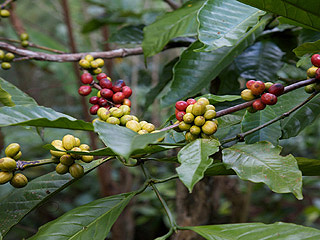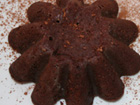Science Coffee Fruit also known as Coffee Cherry or Coffee Berry

Coffee Fruit or Coffee Cherry is about the size as a grape
ABOUT THE COFFEE FRUIT
The Coffee fruit is a bright red, cherry-like fruit about the size of a grape that protects the seed or coffee bean within the fruit. Just like ordinary cherries, the coffee fruit is also a so-called stone fruit. Even though the coffee beans are not technically beans, they are referred to as such because of their resemblance to true beans. Coffee beans are actually the seed, or pit, of the fruit that grows on coffee trees.
The fruits; cherries or berries, most commonly contain two seeds with their flat sides together. A small percentage of cherries contain a single seed, instead of the usual two. This is called a "peaberry". The peaberry occurs only between 10% and 15% of the time. Peaberry coffee tastes different from the coffee from normal beans from the same crop because the different bean shape leads to different roasting characteristics. Peaberry coffee is typically more brightly acidic, more complex in the upper aromatic ranges of the profile but somewhat lighter in body, than coffee made from normally shaped beans from the same batch.
In the production of coffee, the fruit of the coffee plant is typically discarded although there are some health benefit that the fruit contain that is not found in coffee beans (see below -- Health Benefits of Coffee Fruit.
WHAT IS CASCARA?
The process of pulping removes the seed from coffee cherry. When the seeds (or beans are roasted, you get coffee beans. But what happens to the cherry fruit that protects the coffee beans? Typically, the cherry is discarded once it is separated from the seed. In some instances, the cherries can be dried and brewed into a tea . In Ethiopia the cherries have long been been dried and brewed into the beverage called Qishr.
Cascara is the Spanish word for the peel or skin of a fruit. Coffee is a fruit, though most people don't think of it that way. Like cacao, it's processed opposite most fruits: The skin and flesh are discarded, and just the seeds are dried, roasted, and ground to make the beverage many Americans drink daily.
For more information on Cascara see: What is Cascara?
TASTE OF COFFEE FRUIT
Coffee fruit (coffee cherries) have a mild flavor and are slightly sweet. The flavor is similar to that of other red fruits, like a mild mix of fruits like raspberry, red mulberry, currant, cranberry, cherry, raisin. It is possible to dry or dehydrate them or blend them combined with coffee beans in a grinder. The extracted liquid makes for an interesting coffee drink.
HEALTH BENEFITS OF COFFEE FRUIT
ANTIOXIDANT, ANTI-INFLAMMATORY EFFECTS, AND ANTINEOPLASTIC PROPERTIES
The Coffee fruit is high in antioxidant compounds like rutin and chlorogenic acid, protocatechuic acid, and gallic acid ( source ).
"...Accumulating evidence has demonstrated that chlorogenic acid exerts many biological properties, including antibacterial, antioxidant, and anticarcinogenic activities. Recently, the roles and applications of chlorogenic acid, particularly in relation to glucose and lipid metabolism, have been highlighted.... see abstract and source..Roles of Chlorogenic Acid on Regulating Glucose and Lipids Metabolism: A Review.
"...Several beneficial effects are reported for gallic acid, including antioxidant, anti-inflammatory, and antineoplastic properties. This compound has been reported to have therapeutic activities in gastrointestinal, neuropsychological, metabolic, and cardiovascular disorders..." source: Pharmacological effects of gallic acid in health and diseases: A mechanistic review
BRAIN HEALTH
"Brain-derived neurotrophic factor (BDNF) plays an important role in neuronal survival and growth, serves as a neurotransmitter modulator, and participates in neuronal plasticity, which is essential for learning and memory. It is widely expressed in the CNS, gut and other tissues....Decreased levels of BDNF are associated with neurodegenerative diseases with neuronal loss, such as Parkinson's disease, Alzheimer's disease, multiple sclerosis and Huntington's disease. Thus, BDNF may be useful in the prevention and management of several diseases including diabetes mellitus." source: Brain-derived neurotrophic factor and its clinical implications
SEE LATEST RESEARCH ON COFFEE FRUIT:
Coffee Fruit Extract -- a nutritional stimulator of endogenous BDNF -- April 2021
Aroma-Active Compounds in Robusta Coffee Pulp Puree—Evaluation of Physicochemical and Sensory Properties -- June 2021
Related Coffee Sites
See also:
Chemical compounds in coffee that produce aroma and bitterness
Science behind pulling the perfect espresso shot
